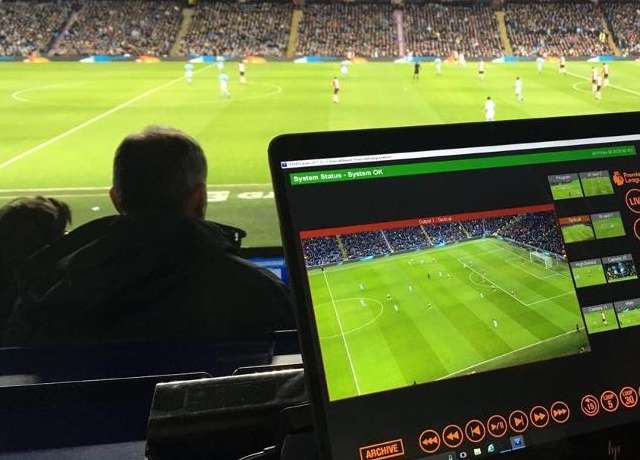Technology in and around sports continues to change to enhance the abilities of teams and the enjoyment of viewers. We’ve seen goal-line technology and video-assisted referees transform sports like soccer and hockey, as well as behind-the-scenes data analysis tools refine the scouting and training approach across the board. In fact, one of the newest elite-tier sports stadiums to open, the Tottenham Hotspur is crawling in technological innovations, including its two pitches to suit the Premier League and NFL, four of the largest big screens in Europe, over 1,600 Wi-Fi access points, and the longest bar on the continent. Still, for most, spectating from home or while on the go is the main way to engage with live sports. Here, we’re looking through the innovations that live sports have embraced, some from the wider entertainment scene, to create a more exciting and engaging experience for the viewer.
The power and appeal of live streaming
The Super Bowl LIII halftime show, featuring Maroon 5, Travis Scott, and Big Boi, is one of the main reasons why over 7 million devices streamed the sporting event in 2019.
Given that people have been able to watch things live in person and via a TV for decades, many underestimate just how powerful and appealing live streaming is, particularly in sport. The essential element of the tech is that it’s incredibly cost-effective for both the streamer and often the user, with a lot of streaming just being bundled into a product for free. This is how it truly took off in the online entertainment space, particularly with online blackjack, which live streams dealers to a real-life player somewhere else in the world to play the classic card game in real-time.
The appeal of live streaming with the entertainment product is indisputable, with top casino sites boasting as many as ten live blackjack games, ranging from Live Opal Blackjack to Live 888 Classic. The technology has revolutionized this form of online gaming as it makes the experience more immersive and personal, as opposed to merely clicking a button to play through a video-form game. Now, players react in real-time, watch as physical cards are played, and bet as though they’re actually in a casino through the interactive stream. While sports won’t ever be able to introduce the kind of features that allow fans to play along or influence games or coverage in real-time, they do continue to maximize their audience by offering live streaming options.
In fact, in the US, 86 percent of live streams show sporting events, with some 560 million minutes of Super Bowl action being viewed via streaming in 2019. Accessibility is now essential to the sports fan experience, and streaming will increasingly prove to be key in this regard.
Mobile streaming will only become bigger with better devices
The OnePlus 7T Pro is one of the top HDR10-compatible smartphones on the market, boasting a 1440×3120 resolution AMOLED screen.
Premium sports providers were hesitant to offer sports streaming options for a very long time, fearing that it would overtake their more lucrative TV packages. Eventually, competition forced the hands of the big broadcasters, and now they have to covet their streamed content as highly as their TV productions. The main emphasis with these two lines of live sports is that fans want to have the same high-quality TV but while on the go. Right now, the 4K display has become the epitome of sports viewing, and while most broadcasters can now show sports in 4K, getting that picture to smartphones has been troublesome. This is quite simply because mainstream mobile technology isn’t quite ready to handle such heavy content. There are certainly devices that are compatible with the best picture available, HDR10 – including the OnePlus 7T Pro, Samsung Galaxy S10 series, Xiaomi Mi 10 range, several Sony Xperia XZ models, and the Huawei Mates – but 4G mobile internet can cause problems. Ultra-HD streaming from Wi-Fi isn’t often a problem, but with most Wi-Fi connections coming at home, many will just turn to their TVs. Still, those who want to watch the highest quality sports streams on the go will soon meet their savior: 5G. The fifth generation of mobile internet is going open a tsunami of tech opportunities once it’s been fully rolled out, but for sports fans, it’ll guarantee perfect streams of even 8K matches.
Going all-access and beyond for the fan experience
A YouTube video of BT Sports’ 360o Camera in action. You can click and pull the screen to look around from its position in this video.
In the UK, BT were intent on competing with the storied Sky Sports and draw Premier League viewership to their upstart sports platform. While the commentary, punditry, and presentation were deservedly panned by many, as was fans’ need to now pay for another package, BT Sport has certainly looked to implement technological innovations to further their case. One such aspect that brings fans closer to the action and an in-stadium level of immersion never seen before is that of the 360o viewing experience. This is part of the viewing experience available to fans now, with Watch Together and augmented reality, on-screen graphics also furthering the experience of watching sport. Equally, Sky Sports have also upped their efforts to immerse and engage fans, with them turning to another before unseen perspective. As shown during the newest cricket tournament, The Hundred, and as regularly used with the horse racing, Sky deploys drone cameras to offer a brand new perspective of the action and the surrounding area of the stadium. Perhaps the most revolutionary breakthrough that both Sky and BT deploy on their respective channels and platforms, though, is the video player controls. Even when the sport is being shown live, fans can pause, rewind, and then fast-forward the action so that they never miss anything.
There’s nothing better than watching live sport, but broadcasters around the world covering all of the most popular sports continue to explore new and innovative ways to bring you closer to the action from home. It may not be able to beat the stadium experience, but with the way that the sector continues to develop, the margin between the two may soon be incredibly thin.






